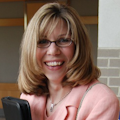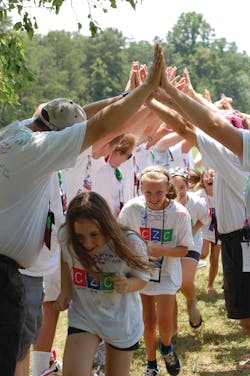Lexi Holmes is a bright, curious and fun-loving little girl, just like many other young girls. She loves to read and would like to turn her playroom into a library. She pours her entire being into drawing, singing or turning cartwheels. She remembers minute details from what she’s read or seen and eagerly shares her insights with her family.
Lexi’s compassionate and sensitive. She knows just how to make her “Momma” smile when she’s having a bad day. Lexi also hates to see other children go without something they need or want. That’s why she insists on making goody bags during holidays for kids who could use a little something extra.
At such a young age, Lexi understands all too well what it’s like to go without something special or important. Lexi’s father, Firefighter/Paramedic Paul D. Holmes of the Douglas County Fire Department in Georgia, died in the line of duty in 2009 when she was just 4 years old. Thanks to the National Fallen Firefighters Foundation (NFFF), Lexi and other children of fallen firefighters went to a special camp in June to help them find something special – a place where other kids understood just how they felt.
The foundation, in partnership with Comfort Zone Camp (CZC), introduced The Hal Bruno Camp for Children of Fallen Firefighters, a free, weekend bereavement camp in Virginia for children between the ages of 7 and 17. They shared their stories, learned skills to manage their loss, and had time to reflect and remember their parents in a positive, fun and nurturing environment.
“This is something the foundation has wanted to do for quite a while, and Hal’s emphasis on taking care of family fit right in with this project,” said Linda Hurley, director of the NFFF’s Survivor Programs.
Lexi’s mother, Jamie Holmes, heard about the camp during the NFFF’s 2012 Fire Service Survivors Conference. Based on her positive experiences with the foundation, she was certain Lexi would benefit from the camp and meeting other children of fallen firefighters.
Comfort Zone Camp was created in 1999 to provide support to children whose parent, sibling or primary caregiver has died. By meeting others with similar experiences and spending time with an adult volunteer – or “Big Buddy” – the children develop coping strategies and build strength as they open themselves to a healing process.
According to Pete Shrock, CZC’s national program director, preparing for each camp takes 10 to 14 weeks. “Through the application, we learn who the child is, how they communicate, details about their grief experience and other needs,” he said.
It takes a team of four highly trained people – not a database – to identify a good volunteer Buddy match for the children. Then they are placed into a small group called a Healing Circle. Each Healing Circle includes a clinical therapist who works specifically with the needs of each group.
“It’s a very intricate process for matching and setting up the child for success,” Shrock explained. “We’re looking to create so much synergy outside the trauma that it makes the tragedy easier to talk about.”
Holmes agreed that the measures CZC took to match a Buddy for Lexi were beyond her expectations, and the parents were very impressed. “The personalities (of the Buddies) matched the kids perfectly. They even resembled the children. It was astonishing for all the parents!” she said.
When partnering with a specific organization like the NFFF, CZC first learns about the culture of the organization and the needs of the campers. Volunteers are recruited and trained about the camp’s philosophy to create a cohesive team. “The entire program moves as one,” said Shrock. “We have to train volunteers to hold their truth because their experience is different than the child’s truth. No one is right or wrong. It’s just different. The child’s view has to guide them.”
The idea of being a Buddy appealed to Battalion Chief Bob Bradley of the Central Falls, RI, Fire Department and the pipe major for the Rhode Island Professional Firefighters Pipes and Drums. Bradley was on the NFFF website when he saw the request for fire service volunteers.
“I had coached my kids’ teams over the years and been involved in their activities, but had never done anything like this,” he said. “When I saw it on the foundation’s site, it really piqued my interest.”
Bradley submitted an application, was accepted and attended the training, which he said was very thorough and answered every possible question. As the first day of camp got closer, he found himself feeling nervous. Although his wife and children were very supportive, he worried if he and his Little Buddy would connect. He wondered if he would he be the right person for this child. To help himself relax, he arrived at the camp early to help set-up and meet the other Big Buddies.
“All of a sudden the kids arrived, and I was the first to meet my Little Buddy,” said Bradley. “I was with the youngest kids and they were all very shy, meeting someone new for the first time.” He also met his Buddy’s mom at the same time and could tell that many parents felt nervous as well.
Holmes agreed. She said Lexi was excited about the idea of going, but got nervous after arriving. Once she saw other children her age and met her buddy, Lexi warmed up. But there was still some anxiety because she had never left Lexi with anyone other than a grandparent. The parents stayed at a nearby hotel for the rest of the weekend.
Soon after arriving, the kids and their Buddies went to a big field to play games. Bradley said this helped tremendously to take the edge off for everyone. Later, they went to the first Healing Circle to let the children talk about grief and share their stories.
“We talk very directly to the kids,” explained Shrock. “We’ll say, ‘We’re going to go to the Healing Circle and talk about how we feel about death and then we’re going to talk about how you felt about it. And tell us where you need help.’ You will literally see kids’ body language change within a few hours because everyone is on the same common ground. It almost neutralizes the fear.”
Following the first Healing Circle, the adults went to a meeting while the children played more games. Shrock explained that by alternating between serious discussions and lighthearted activities the campers and their Buddies are engaged and the experience remains positive.
Saturday morning, everyone participated in a challenge course that included navigating obstacles and climbing walls. The course is an extended metaphor to help the kids feel strong and safe and understand that they can rely on others to help them get through their challenging times.
“Being a chief, I had a hard time keeping my mouth shut during the challenge course and let the kids do what they wanted to do,” said Bradley. “It was really cool to step back and let the little ones make decisions. Watching them help each other and talking to each other was awesome.”
The children brought pictures of parents, stuffed animals or other personal items that reminded them of family to the afternoon Healing Circle. They talked more freely about their parent and were more willing to share their stories. They were encouraged to write notes or draw pictures to their parents. After dinner and a game of charades, everyone went to a bonfire to make s’mores, sing songs and put their notes in the fire so the smoke would take their messages to their parents. Following a path lighted with luminaries, everyone headed back to camp.
The parents returned on Sunday for a brief meeting in which the Healing Circle leaders shared the themes of their group. According to Shrock, the parents can also talk with their child’s Healing Circle leader about the details of what happened during the weekend, how their child reacted and what to expect in the days, weeks and months ahead.
“As firefighters, we show up at the worst of things, but then we pack up and walk away. We don’t see the aftermath of the firefighters’ funerals,” said Bradley. “These kids have to deal with someone who isn’t there anymore. To see it through their eyes brought it to a whole new perspective. The first thing I did when I got home was hug my kids, who are 23 and 21.”
According to Holmes, the camp helped her daughter become comfortable talking about her father’s death. “It was the first time Lexi was able to say out loud ‘My Daddy died,’ ” said Holmes. “Her grandparents noticed two weeks later that she had opened up even more. Now she’s willing to talk about her dad and how she feels about him not being here anymore.”
Hal Bruno’s Legacy
The Hal Bruno Camp for Children of Fallen Firefighters honors the memory of Hal Bruno, the late chairman emeritus of the National Fallen Firefighters Foundation (NFFF) Board of Directors and longtime Firehouse® Magazine political columnist who died in 2011. His priority as chairman was to ensure the survivors of the fallen received the help they needed to pick up the pieces and begin rebuilding their lives.
“Hal was wholly dedicated to helping the survivors find the support and comfort they need as they rebuild their lives following the death of their firefighter,” said Chief Ron Siarnicki, executive director of the NFFF. “For the foundation to offer a fun and therapeutic camp just for the children of the fallen would make him very proud.”
The foundation covers the costs for all the campers as well as the lodging and local travel expenses for the parents.
“We wanted to be certain that any children who want to take part in this valuable weekend will have that opportunity,” said Linda Hurley, director of the NFFF’s Survivor Programs. “We are very grateful that a bequest from the Bruno family enabled us to offer the camp.”
Other support for the camp is provided by a grant from the Department of Justice Bureau of Justice Assistance and a donation from State Farm.
Further information about the Hal Bruno Camp for Children of Fallen Firefighters and other NFFF programs is available at www.firehero.org or by contacting Hurley at [email protected].
—Molly Natchipolsky
About the Author

Molly Natchipolsky
Molly Natchipolsky is a writer with the National Fallen Firefighters Foundation. Before joining the Foundation she worked in public relations and communication for several non-profit organizations including the National Osteoporosis Foundation, the International Food Information Council and the American Red Cross.
